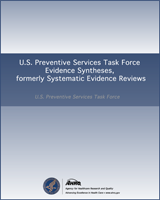NCBI Bookshelf. A service of the National Library of Medicine, National Institutes of Health.
Chou R, Huffman L. Screening for Human Immunodeficiency Virus: Focused Update of a 2005 Systematic Evidence Review for the U.S. Preventive Services Task Force [Internet]. Rockville (MD): Agency for Healthcare Research and Quality (US); 2007 Apr. (Evidence Syntheses, No. 46.)
This publication is provided for historical reference only and the information may be out of date.

Screening for Human Immunodeficiency Virus: Focused Update of a 2005 Systematic Evidence Review for the U.S. Preventive Services Task Force [Internet].
Show detailsLiterature Search and Strategy
We limited our review to references cited in the revised 2006 CDC recommendations3 and published in 2004 or later (as the main searches for the 2005 evidence synthesis were conducted through June 2004), and to a list provided by the CDC of other new studies reviewed but not included as references in its revised recommendations.
Inclusion / Exclusion Criteria
A single reader reviewed all citations. Papers were selected for full review if they were about HIV infection and evaluated the effects of screening on high-risk behaviors, rates of sexually transmitted diseases, or HIV transmission rates in adults and adolescents in outpatient, low-risk (i.e., not high risk or high prevalence) settings. High prevalence was defined as >1% and high risk settings were defined as in the 2001 CDC guidelines.11 We also included studies evaluating the yield of different risk assessment methods; acceptability of HIV screening; impact of streamlined counseling or testing methods on test uptake, clinical stage at diagnosis, and rates of entry into medical care; effects of repeat screening at different intervals; and cost-effectiveness of screening. We included studies performed in the U.S. or Australia, Canada and countries of Western Europe, in which the epidemiology and management of chronic HIV infection are similar. When important new studies for a specific key question had only been performed in other countries, these were reviewed as well.
Data Extraction and Synthesis
We used predefined criteria from the USPSTF to assess the internal validity of included systematic reviews, trials, observational studies, and cost-effectiveness analyses, which we rated as good, fair, or poor.12, 13 We also rated the applicability of each study to the population likely to be identified by screening and the overall body of evidence for each key question. The rating system was developed by the USPSTF and is described in detail elsewhere and summarized in Appendix 1.12 For included studies, we abstracted information about setting, patients, interventions, and outcomes.
Size of Literature Reviewed
Investigators reviewed 116 abstracts published in or after 2004. Of these, 6 were already cited in the 2005 evidence synthesis, 67 were excluded because they evaluated high-risk, high-prevalence, pediatric, or prenatal populations or were conducted in Asia or Africa, 10 contained no original data (editorials, letters, or non-systematic reviews), 23 did not address areas relevant to our scope, and 1 did not report interpretable outcomes. Nine full-text articles were retrieved, including two randomized controlled trials14, 15 and two systematic reviews.16, 17 After review of the full-text articles, neither randomized trial met inclusion criteria because they evaluated high-risk patients (STD clinic patients and men who have sex with men). An observational study was also excluded after full-text review because it took place in a high-risk setting.18 Two systematic reviews met inclusion criteria and evaluated rates of risky behaviors before and after HIV testing.16, 17 One17 was an update of a systematic review19 included in the 2005 evidence synthesis. Other studies meeting inclusion criteria included a survey of the general population that included information on test acceptability,20 an observational study of outpatients and inpatients evaluating test acceptability,21 a modeling study estimating effects of HIV screening on sexual transmission,22 and a cost-effectiveness analysis of screening.23
- Methods - Screening for Human Immunodeficiency VirusMethods - Screening for Human Immunodeficiency Virus
Your browsing activity is empty.
Activity recording is turned off.
See more...
